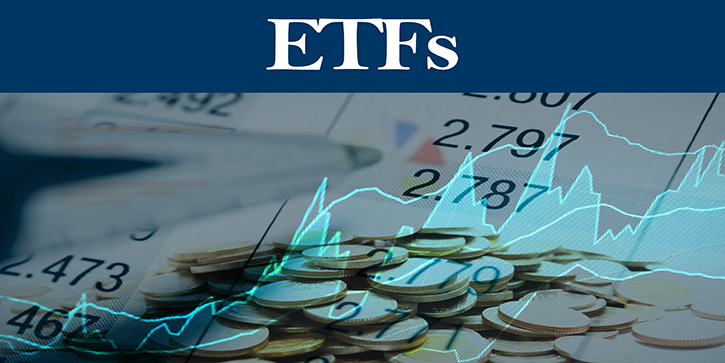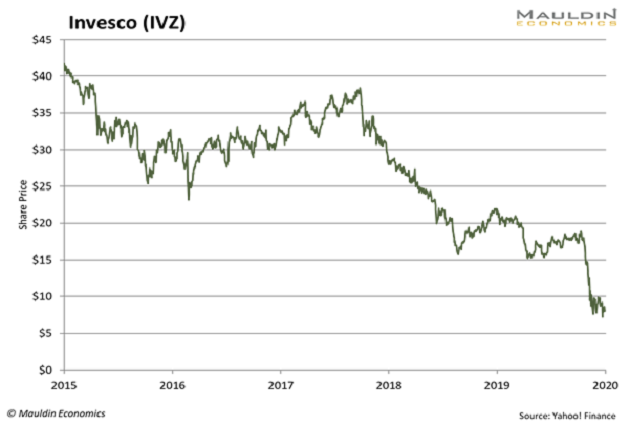
Worrying about ETFs
-
 Jared Dillian
Jared Dillian
- |
- May 7, 2020
- |
- Comments
As long as I can remember, people have worried about ETFs.
I was trading ETFs back in 2005. And my partner and I used to wonder if ETFs would increase correlation in the stock market—the property that stocks moved together, like a marching band.
Over a short time horizon, like in seconds and minutes, this was true. If someone bought the Energy Select Sector SPDR (XLE), then they bought energy stocks like ExxonMobil (XOM), Chevron (CVX), and ConocoPhillips (COP) all at the same time via this ETF.
But over longer periods of time, there were wide divergences in performance among the stocks. In fact, realized correlation across the market dropped dramatically. So the thesis that ETFs would increase stock market correlation was bunk.
People thought ETFs might have had something to do with Kweku Adoboli’s rogue trading at Swiss investment bank UBS, but they didn’t. People thought ETFs might have had something to do with the 2010 flash crash, but they didn’t.
I think some of the criticisms of indexing are legitimate—that they are responsible for price-insensitive buying. Or that, when you buy an index, you not only get the return of the index, you also get the volatility of the index.
As long as I can remember, people have predicted that ETFs would break, and they haven’t broken. Diverging from their intraday net asset value doesn’t count. The fund structure is pretty much indestructible.
Journalists have spent countless hours trying to figure out how the creation/redemption process would fail, but it hasn’t. It’s just bulletproof.
There are exotic ETFs that do weird things and are difficult to understand. If you avoid those, you should be fine.
I ran an ETF desk before ETFs were widely adopted among retail investors. Before 2008, they were mostly used by hedge funds for… day trading. I probably spent most of my time trading ETFs that track the S&P 500 and Nasdaq 100—specifically, the SPDR S&P 500 (SPY) and Invesco QQQ Trust (QQQ)—from 2004 to 2008.
I can tell you that, these days, ETF desks are not spending their time trading SPY and QQQ on a tactical basis. Rather, they’re facilitating large, strategic allocations to a wide range of ETFs.
The ETF business has totally changed. It’s more boring, which is a good thing.
I still think open-end mutual funds are better vehicles in some situations. John Bogle himself, the late founder of Vanguard, worried about the fact that they were listed on an exchange and could be traded actively. That was a valid concern.
But the ETF business has done a number on traditional asset managers like Invesco (IVZ), who were late to the ETF game.

Some think that ETFs will completely kill off open-end mutual funds. I think they will coexist peacefully, and I even think that open-end funds will one day make a comeback.
Like what you're reading?
Get this free newsletter in your inbox every Thursday! Read our privacy policy here.
Liquidity
One of the underappreciated aspects of ETFs that people forget about is the existence of country ETFs.
Country ETFs were an incredible financial innovation. International investing hasn’t been all that profitable lately, but not too long ago, it was.
In the 2000s, it was difficult to find country-specific open-end funds, and if you did, they had the potential to underperform (or outperform) the index. As early as the late 1990s, you could invest in places like Italy, Austria, or Asia ex-Japan very cheaply.
When the iShares MSCI Emerging Markets ETF (EEM) burst onto the scene in 2003, emerging market investing was still in its early days. This was even pre-BRICS (Brazil, Russia, India, China, and South Africa—the major developing economies).
The early EEM had virtually no liquidity, with bid-ask spreads nearly 1% wide. (Which meant a lot of people overpaid to get into that trade.) It traded fewer than 100,000 shares a day.
This ETF has come a long way since then. Through technology, EEM has become one of the most liquid ETFs in existence, with bid-ask spreads a penny wide. It now trades tens of millions of shares a day.
The same is true of small-cap stocks—the iShares Russell 2000 ETF (IWM) wasn’t exactly liquid in the beginning. In both cases, the ETF became many times more liquid than the underlying stocks. This became possible through technological and mathematical advancements.
When people examine the rise of ETFs, they typically leave out the role that technology has played in their growth. If market-makers were hedging with a straight basket of stock, this kind of liquidity would not be possible.
My guess is that people probably take for granted that they can buy a basket of highly illiquid stocks from countries around the world, pay zero commissions, and have zero market impact.
We’re to the point where investing, even in out-of-the-way places, is essentially free. This is not typically the news you read about ETFs.
Free in terms of commissions, yes. But you still need to know what you’re doing to make real money with ETFs... or know someone who does. This is where my premium monthly investment service, ETF 20/20, comes in.
The liquidity stuff holds true for bond ETFs, too. Outside of Treasury bonds, bonds aren’t terribly liquid. If you knew the mechanics of how high-yield bonds are traded within the iShares iBoxx $ High Yield Corporate Bond ETF (HYG), for example, you’d probably be pretty impressed.
HYG isn’t a perfect product—it invests in a subset of high-yield bonds that tend to be pretty overpriced (especially when the Fed is buying it). But it’s an index, and we look to indices for the performance of the underlying sector. It performs that function pretty well.
There is a whole generation of traders that looks at HYG to find out how high-yield bonds are doing, rather than talking to a bond trader.
And it’s been a long time since the flash crash, and we haven’t had another one, not even during the March meltdown.
Like what you're reading?
Get this free newsletter in your inbox every Thursday! Read our privacy policy here.
ETFs have been around for 24 years. If they were going to blow up, they would have done it already.

Jared Dillian
P.S. If you are investing in any of the ETFs we talked about today, do your due diligence and keep your position sizes small. But if you would rather not do this on your own, I can help. Get my specific recommendations—including what to buy, what price to pay, and when to take profits—sent straight to your inbox. Click here to see how.
subscribers@mauldineconomics.com
Tags
Suggested Reading...
|
|

 Jared Dillian
Jared Dillian

